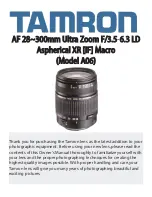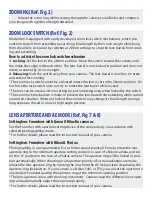
PRECAUTIONS IN SHOOTING
The Tamron lenses 28-300 mm (Model A06) employs an internal focusing (IF) system
to achieve remarkable minimum photographing distances of 0.4 to 0.49 meter (1.31 to 1.61
feet). Because of the characteristics of this optical design, the angles of view at distances
other than infinity are wider than that of the lenses applying an ordinary focusing system.
When the built-in flash on the camera is used, adverse photographic phenomena
such as corner illumination fall-off or vignetting at the bottom part of the image may be
observed, especially in wide-angle ranges. This is due to the inherent limitation of coverage
of the built-in flash, and/or the relative position of the flash to the edge of the lens barrel,
which cause shadows on the image. It is strongly recommended to use a suitable separate
flash unit provided by the camera manufacturer for all flash photography.
* For further details, please read the "built-in flash" article on the instruction manual of your
camera.
When using the lens in the telephoto focal range, it may be necessary to use a tripod
to avoid camera shake. Using high-speed film (ISO 400 or faster) with a fast shutter speed is
also helpful to reduce the influence of camera shake.
Do not hinder the autofocusing movements of the lens. Such interference may cause
a serious damage on the lens mechanism.
Certain camera models may indicate inappropriate maximum and minimum aperture
values. This is inherent to the design of the camera and not an indication of an error.
Please carefully select the filters for your lens, especially when choosing special filters,
such as a PL filter. An ordinary PL filter has a rotating rim that increases the dimensions of
the filter rim to a size larger than a regular filter (thicker filter rim). Using a larger rim may
result in the blurring of all four corners of the photograph taken. For this reason, we recom-
mend filters with thinner rims that are common for wide-angle lenses.
TO ENSURE LONG-TERM SATISFACTION
Avoid touching the glass element surface. Use a photographic lens cloth or blower
brush to remove dust from the lens element surface. When not using the lens, always place
a lens cap on it for protection.
Use a lens cleaning tissue or lint cloth with a drop of cleaning solution to remove fin-
gerprints or dirt on the glass lens surface with a rotary motion from the center to the edge.
Use a silicon cloth to clean your lens barrel only.
Mildew is an enemy of your lens. Clean the lens after shooting near water or in any
humid place. Store your lens in a clean, cool and dry place. When storing the lens in a lens
case, store it with commercially available drying agent such as silica gel, and change the
agent occasionally. If you find mildew on your lens, consult a repair shop or a nearby photo-
graphic store.
Summary of Contents for A06
Page 2: ......








